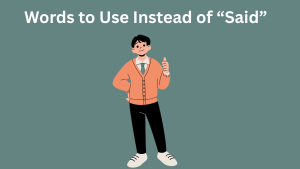Have you ever read a story and noticed “he said” appears dozens of times—sometimes back‑to‑back? You probably skimmed past it without realizing how monotonous it sounded. Yet, when another author swaps in “he whispered,” “he snapped,” or “he retorted,” the effect is instantly richer and more vivid.
In this article, you’ll discover over 500 carefully chosen words and techniques that breathe life into your dialogue and narration. More than that, you’ll learn when to use them, why it matters, and how to avoid the most common pitfalls. By the end, you’ll feel confident leaving “said” behind—or using it seamlessly—so your readers stay hooked from the first line to the last. Whether you’re a beginner or a seasoned writer, this guide has something valuable for you.
1. What Is “Dialogue Tagging,” Anyway?

Dialogue tagging means adding a short phrase—like “he said” or “she asked”—to indicate which character is speaking. It’s essential for clarity and pacing:
- Clarity: Helps readers know who is speaking, especially in multi‑character scenes.
- Pacing: A well‑placed tag can slow a conversation down or keep it flowing.
“He said” is considered a neutral or invisible tag—it does the job without drawing attention. But we’ll see soon why variety matters.
2. Why Varying “Said” Matters: The Reader’s Perspective
From “He Said” to “He Snapped”: Emotion in a Word
Picture this dialogue:
“Leave me alone,” he said.
Now try this:
“Leave me alone,” he snapped.
Suddenly, tension rises. It’s one word, but it adds a punch: your character sounds angry, upset, maybe closing a door or raising their voice. With a single tweak, you enrich tone and emotion.
Boosting Engagement and Voice
Readers skim “he said” until it becomes invisible. But meaningful verbs like exclaimed, murmured, or grumbled engage them. They see character traits—sarcasm, kindness, frustration—without us spelling it out later.
Better Flow
If you’re writing for the web, mixing rich synonyms—like “alternatives to said,” “dialogue tag synonyms,” “words instead of said”—helps your article naturally rank for related search terms. And it keeps readers reading.
3. Understanding the Categories: A Logical Framework
We’ve organized 500+ tags into nine main categories. Each reflects different emotions, tones, or functions—naturally helping you choose the right word.
- Neutral / Multi‑purpose
- Happy / Excited
- Sad / Upset
- Angry / Tense
- Frightened / Fearful
- Sarcastic / Mocking
- Official / Argumentative
- Asking / Questioning
- Revealing / Informational
- Obscure / Rare
Below, we’ll list examples in each category and show you usage, nuance, and style tips.
4. Neutral / Multi‑Purpose Tags (≈80+ Verbs)
These are safe, workhorse tags that maintain neutrality without drawing attention:
- remarked
- replied
- responded
- noted
- added
- commented
- observed
- stated
- explained
- reported
When to use: In everyday dialogue where emotion is minimal but you need variety or clarity.
Example:
“The train leaves at noon,” she remarked.
“Thanks,” he replied.
5. Happy / Excited Tags (≈60 Terms)
Capture joy, enthusiasm, or energy:
- exclaimed, gushed, laughed, cheered
- bubbled, whooped, beamed, exhorted
Example:
“We won!” she exclaimed, jumping up and down.
6. Sad / Upset Tags (≈40 Terms)
Convey sorrow, disappointment, and emotional weight:
- sobbed, sighed, cried, whimpered
- moaned, lamented, weeped, groaned
Example:
“I can’t go,” he whispered, his voice trembling with emotion.
7. Angry / Tense Tags (≈70 Terms)
For tense or confrontational dialogue:
- snapped, yelled, barked, growled
- snarled, roared, ranted, fumed
Example:
“Get out of here,” she barked, slamming the door behind her.
8. Frightened / Fearful Tags (≈40 Terms)
When characters are scared or anxious:
- trembled, quavered, hissed
- gasped, stammered, shuddered, hesitated
9. Sarcastic / Mocking Tags (≈40 Terms)
Best for irony or playful contempt:
- sneered, scoffed, mocked, taunted
- quipped, snarked, jeered
Example:
“Oh yeah, that sounds like a great idea,” he sneered.
10. Official / Argumentative Tags (≈60 Terms)
Best for serious or formal dialogue:
- declared, asserted, insisted, contended
- maintained, proclaimed, affirmed
11. Asking / Questioning Tags (≈40 Terms)
To show inquiry or demand:
- asked, inquired, queried
- demanded, pleaded
12. Revealing / Informational Tags (≈40 Terms)
Ideal for expository dialogue:
- revealed, disclosed, explained
- recounted, reported, notified
13. Obscure & Rare Tags (≈70 Terms)
These are colorful, unusual, and mostly best used sparingly:
- avouched, averred, ejaculated, blazoned
- spluttered, droned, intimated, promulgated
Caution:
Some of these (like “ejaculated”) can feel archaic, jarring, or unintentionally comedic. Use with care, or avoid.
14. When to Use “Said” (Yes, You Still Can)
Believe it or not, “said” is still one of the most effective tags—when used right.
The Case for Simplicity
- Invisible to the reader: Doesn’t distract.
- Clear and direct: Works best with rapid-fire conversation or no emotion.
Example:
“Did you eat?” she said.
“Yes,” he said.
“Did you enjoy it?” she said.
Using anything else repeatedly in place of “said” might feel overdone.
But Avoid “He Said Really Angry”
Don’t muddy the waters. Instead of:
“You better listen,” he said angrily.
Use:
“You better listen,” he snapped.
15. Best Practices: Choosing the Right Tag
Match Tag to Emotion
Think: What is happening in the moment? If there’s tension—“snapped” is stronger. If it’s a quiet confession—“murmured” may suit you better.
Use Action Beats Instead of Tags
Rather than:
“I’m leaving,” she said.
Try:
She grabbed her coat from the rack. “I’m leaving.”
Action beats can replace or support tags, and show rather than tell.
Read It Out Loud
Does the dialogue flow naturally? If something sounds stiff, try a different tag or even just use “said” or an action beat.
Balance and Variety
Rotation by category helps—don’t use “exclaimed” when there’s no excitement. Tag sparingly. Think of reading: if you notice the tag, it might be too strong.
16. Common Mistakes & How to Take Back Control
Over‑Tagging
Some writers tag every line:
“Hi,” she said.
“How are you?” she said.
“Nice weather,” she said.
Instead: let conversation breathe. Remove tags when speaker is clear.
Tag + Adverb Redundancy
Avoid:
“Stop that,” he said angrily.
Either:
“Stop that,” he snapped.
Or:
He growled, “Stop that.”
Archaic or Odd Tags
“Ejaculated” is legal but jarring. Avoid words that stand out for the wrong reasons.
Tone Inconsistency
The tag should match your character’s tone, culture, and voice. Don’t mix:
“That’s fabulous,” she snarled.
Unless you’re going for irony—use tags carefully.
17. Real‑World Examples: How Tag Swaps Shift Meaning
Example 1
Original:
“I love you,” he said.
“I love you too,” she said.
Improved:
“I love you,” he murmured, eyes glistening.
She beams. “I love you too.”
Example 2
Original:
“You broke it,” she said.
Improved:
“You broke it,” she accused, holding up the cracked mug.
18. Beyond Tags: Other Ways to Spice Dialogue
Use Action Beats
Action beats (like footsteps, gestures) give context and depth.
Short Dialogue + Beats = Tension
“You lied.” He slammed his fist.
“I didn’t.” She backed away slowly.
Build Rhythm
Short lines: quick pace. Long lines: slower, introspective.
Let Dialogue Stand Alone
Sometimes no tag is needed:
“What now?”
She closed her eyes.
“Now, we wait.”
19. Trends & Insights for Writers
Minimalist Dialogue
Some modern fiction leans toward fewer dialogue tags, instead relying on beats and context for clarity.
Voice‑Driven Choice
Your choice between “said,” “said quietly,” or “said harshly” all conveys character personality beyond words. Use it to deepen reader immersion.
20. Practical Cheat Sheet (Quick Reference Lists)
| Emotion / Purpose | Tag Examples |
|---|---|
| Neutral | replied, noted, added, stated, commented |
| Happy / Excited | exclaimed, cheered, bubbled, whooped |
| Sad / Upset | sobbed, whimpered, lamented, sighed |
| Angry / Tense | snapped, growled, snarled, barked |
| Fear / Anxiety | quavered, hesitated, stammered, trembled |
| Sarcasm / Mocking | sneered, scoffed, jeered, snarked |
| Official / Formal | declared, insisted, contended, proclaimed |
| Questioning | inquired, demanded, queried, pleaded |
| Informational | revealed, explained, recounted, notified |
21. Downloadables & Further Resources
- Printable 500+ Tag Cheat Sheet: Organized by emotion.
- Action‑vs‑Tag Flowchart: Helps decide whether to choose a dialogue tag or an action beat.
- Top Writing Guides:
- Reedsy’s extensive synonym list
- YourDictionary’s tagged usage examples
- Style blogs on “when to use said”
22. FAQ: Your Questions Answered
Q: Is “said” ever wrong?
No. It’s clear, unobtrusive, and widely accepted—at the right time.
Q: How many different tags can I switch between?
No hard rule—but avoid using an obscure tag just for variety. Instead, rely on neutral tags, beats, and emotion‑rich tags when necessary.
Q: When do I skip tags entirely?
When speaker identity is obvious, or when beats or noise make sense:
She yelled, “Help!”
A crash.
Silence.
Q: Can I mix dialogue tags with adverbs?
In moderation. Prefer “he snapped” over “he said angrily.” But “she whispered softly” can sound natural at times.
Q: Should I aim to use many tags?
Not really. The goal is clarity and tone. If a tag makes your dialogue feel earned and emotional, use it. If it feels forced, skip it.
Q: Are archaic tags okay?
Most are outdated or tonal distractions. Use sparingly, or for period pieces—and make sure they fit.
Q: How do I memorize or maintain so many tags?
Download the cheat sheet. Try a word‑cloud tool. Practice by rewriting your own scenes with alternate tags.
23. Final Thoughts: Your Next Steps
- Download the sheet of 500+ tags.
- Practice rewriting a scene or conversation using more emotive tags and beats.
- Listen to feedback: Does the dialogue feel tighter, more vivid?
- Publish with confidence—and feel free to share your favorite tag in the comments!
You now have everything: definitions, tags, usage advice, mistakes to avoid, and even SEO insights. Whether you’re crafting dialogue for a novel, a blog post, or a script, this guide has given you all the tools to elevate your writing — so you never have to settle for another dull “said.”
Happy writing!
Believing in your words,
Your Writing Friend
Read More:
Beyond “Proud of You”: 60+ Unique Ways to Celebrate Achievements
Deven Kumar is the passionate writer and founder behind povforbook.com, a website dedicated to exploring unique perspectives in literature and storytelling. With a deep love for books, language and traveling, Deven aims to inspire readers by sharing insightful reviews, thought-provoking synopses, Guiding tourist by sharing personal experience and engaging content that highlights the power of narrative. When not writing, Deven enjoys connecting with fellow book lovers and traveling lovers and continuously discovering new voices in the literary world.
